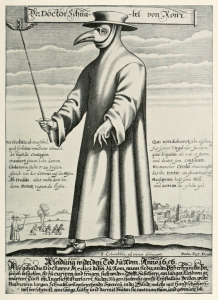Tags
Albert Camus, bubonic, Derbyshire, England, Geraldine Brooks, plague, scientific revolution, seventeenth century, superstition
Review
Geraldine Brooks, Year of Wonders: A Novel of the Plague
Penguin, 2002. 304 pp. $16
Where, you may ask, can you find wonder in a novel about a bubonic plague epidemic that causes apocalyptic losses and prompts superstitious people to destroy each other?
Yet wonder there is, and a tiny Derbyshire village in 1666 becomes the water droplet in which a microscope reveals the world. Anna Frith, a young widow who supplements her meager living by serving the rector as housemaid, throws herself into the tasks imposed by a lethal disease that nobody understands. Apprenticing herself to the charismatic, tireless, and moody Rector Mompellion and his thoughtful wife, Elinor, Anna comforts the dying, mourns the dead, and tries to protect the survivors from each other–when she can.

A plague doctor, Marseilles, from an engraving by Paul Fürst, about 1721. The beak contains material thought to ward off the disease. (Courtesy Wikipedia.)
Through these thankless, seemingly pitiful efforts, Anna creates a wonder: herself. In this hottest of crucibles, she tests her abilities, courage, fears, religious beliefs, and ideas about love, tempering her character and soul. Year of Wonders is a coming-of-age story, among other things, and seldom have I read such an intelligent, unsparing, limpidly written, and satisfying one as this.
A novel with this background reminds me of Albert Camus’s philosophical masterpiece, The Plague, in which Dr. Rieux, the hero, does all he can to combat the disease, though he knows his work has no effect. Camus’s plague is an allegory for Nazism, to which the only antidote is belief in humanity, feeble though that seems. (By the way, he wrote his first draft where Village of Secrets by Caroline Moorehead takes place. See my review, “The Just and Unjust,” December 15.)
Year of Wonders is, of course, a very different book, but Anna is herself a thinker, in her feet-in-the-soil way, and that, too, underlies the title. She repeatedly asks herself whether God sent the plague, and why, a prime question of the late seventeenth century, when Europeans were beginning to embrace scientific observation, not divine writ, as the key to deciphering the natural world. Her answers to this question change over time, and, fitting her character, occur in such ordinary moments as when she stubs her toe or takes a horse out for exercise. Though Brooks never makes this explicit–properly so–Anna, the rector, and Elinor represent the cusp of a frightening yet liberating discovery, the role of random chance. How they react to their gradual, hard-won insights makes this a rich, engrossing story.
Year of Wonders is the third Geraldine Brooks novel I’ve read, and, like the other two (Caleb’s Crossing; March), she shows a sure hand with the language, ways, and social beliefs of the time. However, I prefer this novel (her first), because it feels fuller, somehow, more compact and direct, elegant in its simple framework while exploiting its angles and surfaces. I had a little trouble with the narrative, at first, trying to figure out the sequence of events, but that soon resolved. The ending, though very satisfying, may not be entirely plausible, but I like its irony, and it reinforces what Brooks is trying to say.
I heartily recommend this book, which has given me a great deal to think about, as a reader and novelist.
Disclaimer: I borrowed my reading copy of this book from the public library.

Nice analysis! I happen to have just done a review on The Sea Close By by Albert Camus. You may want to check it out : )
LikeLike
Thanks, I will.
LikeLiked by 1 person
Pingback: Harsh Necessity: The Secret Chord | Novelhistorian